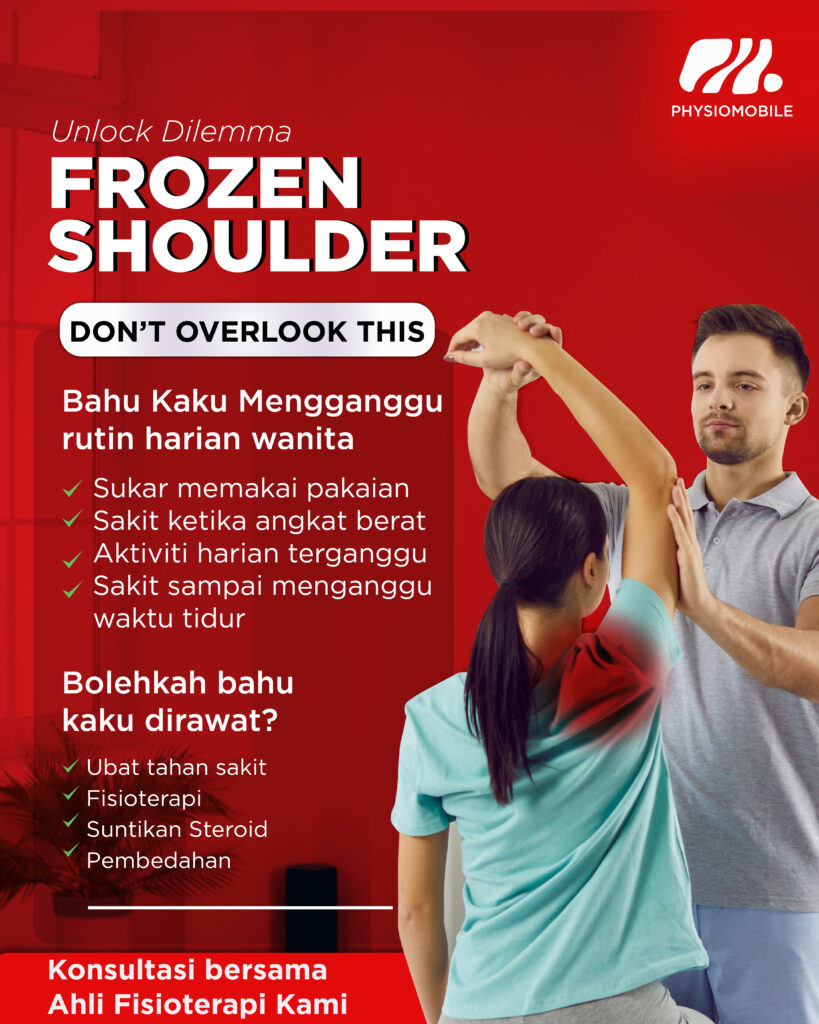Frozen Shoulder Home Exercise You Should Try
Many can agree that having joint pain is one of the most annoying and bothersome problems to have. Some of the common joint pains include a frozen shoulder. Also known as adhesive capsulitis, a shoulder that is frozen can be defined as a condition where your shoulder joint feels stiff and painful to move. The shoulder capsule becomes thicker, tighter and harder to move around. The amount of synovial fluid – the joint lubricant inside the shoulder capsule will also decrease. Movement of the shoulder can cause scar tissues to form in the joint and this condition can gradually worsen over time if not treated properly. In this article, we will go through the common symptoms, possible causes and a few home exercises that you can try to treat a frozen shoulder.
Keep on reading to learn more!
3 main phases of frozen shoulder
If you feel like your shoulder is stiff and your movement causes you pain, you’re most likely experiencing a frozen shoulder. There are 3 main phases of a frozen shoulder, each with different symptoms, timeline and level of pain:

(1) Freezing phase
In this stage, you’ll start to feel pain, sometimes even severe pain during the night, each time you move your shoulders. The pain will also gradually worsen. Your shoulder movements are also limited due to the pain and this stage can last between 6 to 9 months.
(2) Frozen phase
At this second stage, your shoulder will become much stiffer and harder to move around. This will make it very hard to carry out your daily tasks and routines normally. However, you might feel less pain in your shoulder compared to the first stage. This stage can last between 4 months to a year.
(3) Thawing phase
In this stage, the pain will have subsided and your shoulder will no longer feel as stiff. Hence, you’ll be able to move your shoulder like usual and go on about your day-to-day tasks. This last stage where your frozen shoulder heals completely can take up to 6 months to 2 years long.
Although a frozen shoulder can heal after a while, it takes about 3 years to go away and nobody wants to endure such pain for so long. Hence, when given the opportunity you should get it treated.
Causes of frozen shoulder
Immobility resulting from; (1) a previous shoulder injury, (2) a broken arm, or (3) a stroke is one of the most prevalent causes of frozen shoulder. Aside from injuries, it has been found that women are more prone to having a frozen shoulder than men, and commonly affects those who are between 40 to 60 years old. Medical conditions such as diabetes, thyroid disease, Parkinson’s and heart diseases can also lead to a frozen shoulder. Studies show that 10-20 percent of diabetic patients suffer from this issue. Understand more about frozen shoulder.
4 Home exercises for frozen shoulder
There are a few at home exercises that you can do to help relieve a frozen shoulder. Before you attempt these exercises, make sure to warm up your shoulder by taking a warm shower first.
Watch Video for better understanding.
(1) Cross arm stretch
A great stretch you can do at home for a frozen shoulder is the cross arm stretch. This stretch is very common and easy to perform.
Firstly, bring your affected arm across your chest horizontally. Then, support your affected arm with your other arm and stretch the shoulders by exerting a gentle pressure with the other arm.
Hold this position for 10 to 30 seconds and repeat this exercise 10 to 20 times every day.
(2) Finger walk
Find a wall and face it. Then, touch the wall with your pointer and middle fingers of your affected arm.
Starting from your waist level, slowly walk your fingers up the wall as high as you can. Make sure to use your fingers only and not engage your shoulder muscles while doing this.
After raising your arm as high as you can, slowly walk them back down and repeat this motion for 10 to 20 times every day.
(3) Towel stretch
Another at home stretch that you can do is the towel stretch. Hold one end of the towel behind your back and the other end over the back of your shoulder so that the towel is in a vertical position.
Your good arm should be the one at the top. Pull the injured arm upward with your good arm to stretch your frozen shoulder.
(4) Pendulum stretch
To do this exercise, find a table or railing that you can lean on. Then, relax your shoulders and hang the frozen shoulder down while supporting your body on the table with the other arm. Swing the hanging arm and make small circles. Do at least 10 circles in each direction every day.
As your shoulder pain improves, gradually swing your arms in bigger circles. You could also hold a light weight such as a water bottle in your hands while swinging if you’re comfortable with it.
In conclusion, there are plenty of exercises that you can do and follow to help relieve a frozen shoulder. If you’re currently suffering from a frozen shoulder and are seeking professional treatment, Physiomobile’s physiotherapy is the perfect solution for you!
Since 2016, we’ve helped more than 30,000 patients regain their confidence, eliminate their fear of pain, and restore their happiness to have a healthy and active lifestyle back on track.

Physiomobile also provides comprehensive and intensive rehabilitation for Neurological Problems, Sport Injuries, Pediatrics, Geriatrics as well as Post-Surgery patients.
What are you waiting for? Head to Physiomobile’s website and book an appointment now!

